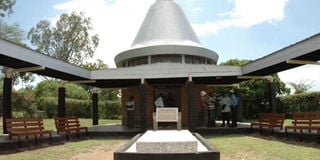BEAUTIFUL KENYA: Priceless relics await visitors at Mboya’s mausoleum in Rusinga

Tom Mboya Mausoleum in Rusinga,Homa-Bay county. PHOTO|JACOB OWITI
What you need to know:
An inscription on the beautiful marble grave reads: ‘‘Go and fight like this man who fought for mankind’s cause, who died because he fought whose battles are still unwon.’’
An outstanding collection that receives the most attention is Mboya’s blood-stained briefcase, which he carried when he was assassinated on that Saturday afternoon of July 5, 1969 on Government Road (now Moi Avenue) in Nairobi.
Many visitors are amazed that the dark green briefcase is still intact.
At Lwanda Kamsengre village on Rusinga Island, a bullet shaped mausoleum of a man whose death changed Kenya’s political landscape stands tall as a stark reminder of a hero whose life was nipped in the bud by an assassin’s bullet.
Tom Mboya’s mausoleum on the island built two years after his assassination in 1969, is a historical site. Thousands of visitors flock to the site annually to learn about the life of a man whose brilliance and outstanding contribution to Kenya’s independence is still revered.
The mausoleum was gazetted as a national monument on March 9, 2001 because of Mboya’s contribution to Kenya’s independence struggle.
UNIQUE SOUVENIR
Inside the architecturally marvelling mausoleum, the black fly-whisk the youngest minister in the first Cabinet of 27 after independence carried to his political functions is displayed.
Books and laminated newspaper cuttings illustrating Mboya’s independence struggle are at the entrance while a black nameplate — a unique souvenir given to him by the Chinese Government, which Mboya placed on his desk when he was a minister — is also displayed beside several flags of the nations he visited and whose leaders paid him courtesy calls.
An inscription on the beautiful marble grave reads: ‘‘Go and fight like this man who fought for mankind’s cause, who died because he fought whose battles are still unwon.’’
An outstanding collection that receives the most attention is Mboya’s blood-stained briefcase, which he carried when he was assassinated on that Saturday afternoon of July 5, 1969 on Government Road (now Moi Avenue) in Nairobi.
Many visitors are amazed that the dark green briefcase is still intact.
Visitors who are allowed to go through the family albums and other motivational books on display, can also enjoy quite serenity and the cool breeze from the lake while seated on garden benches outside the mausoleum.
The mausoleum has tour guides and is open to the public free of charge daily from 9am to 6pm.
HIGHLIGHTS
Items in the mausoleum
History: Books and laminated newspaper cuttings illustrating Mboya’s independence struggle.
Fly-whisk: The black fly-whisk the youngest minister in the first Cabinet carried to functions.
Briefcase: Dark green briefcase the politician was carrying when he was assassinated.




